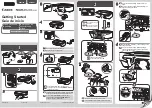
Programming Codes
T480
Programmer’s Guide
Page
170
Rev A
100-14362
Printer Status
Status Inquire
The EPIC 3000 Printer is designed for use as part of an automated system where the
host computer makes every attempt to correct problems with the printer. In addition, the
host application requires that it be able to obtain more information from the printer than
is typical of normal computer printers. For example, a normal computer printer does not
have cash drawers, such additional features require that the standard printer protocol be
extended to deal with the added features of a point-of-sale (POS) printer.
All inquire commands are processed as they are received (preprocessed or real time)
and require a response from the printer. Consequently, parallel, IEEE 1284 bidirectional
communications, USB or bidirectional serial operation is required.
The EPIC 3000 Printer looks at and evaluates all commands as they are received, and
does not respond to inquire commands that happen to be embedded in graphics or other
commands. (Refer to the buffer and preprocessor descriptions in later sections.)
In all cases, inquire commands are responded to by an acknowledged (ACK) or a not
acknowledged (NAK) and then the command ID, which allows the host application to
make multiple requests and receive identifiable responses. If the printer is configured for
serial or USB operation the status is automatically returned to the host. If the printer is
configured for parallel, IEEE 1284 operation, the HOST must initiate a reverse channel
request to return the status.
Serial and USB Mode Inquire
All inquire (ENQ) commands require a response from the printer. During serial operation,
all inquire commands are responded to by an acknowledged (ACK) or not acknowledged
(NAK), the command ID, and in some cases status. Most status responses sequences
contain a length field to help decode and separate responses.
In general the printer should be configured for “Buffer Full Only” off-line operation if
inquire commands are used. This prevents the printer from using flow control for
anything but buffer full. The programmer must take on the responsibility for assuring that
inquire commands are used to maintain status of the printer.
The printer always accepts serial data even when it is off-line. The printer has reserve
buffer space that allows additional information to be received even if the printer is
signaling buffer full or off-line. Because inquire commands are processed before they go
into the buffer, the printer responds even when it is busy printing.
In serial mode, the response to an inquiry should be received by the host before another
inquire command is issued to the printer. When the printer receives an inquiry, it
generates a response. If inquiries are sent to the printer too quickly, the printer spends
all of its time responding and does not have time to print.
IEEE 1284 Mode Inquire
In parallel, IEEE 1284 mode, status information can be returned to the host through the
IEEE 1284 reverse channel. After the host makes an inquire request, it activates IEEE
1284 mode 0 reverse channel and waits for a response from the printer. The response to
the inquire is identical to serial mode in format.
















































